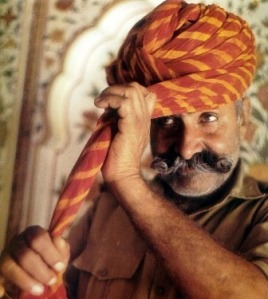An ancient and ever popular technique, tie-dye is a process of resist dyeing textiles typically using bright colors. While there are several variations in technique, the method basically involves patterns of color by folding, tying, stitching, crumpling the fabric to inhibit the flow of the dye into the folds of the fabric. The pattern of the folds and where the colors are squirted determines the final design.
Several variations of the tie-dye technique are evident the world over, from the Shibori in Japan, the Hausa technique in West Africa, Plangi and Tritik in Indonesia to the beautiful Bandhani, Ikat and Leheriya patterns of India.
The now very popular form of “Bandhani” derives its name from the Hindi word Bandhan which means tying up. Bandhani is an ancient art practiced mainly in Western India.
This region is also well known for its Leheriya pattern – literally meaning waves. This technique is quite different to the Bandhani as here the fabric is rolled from one corner to the other diagonally and then it is tied at intervals with strings. An astounding variety of Leheriya prints are produced using the simple process of tying and dyeing. The Panchranga technique, using five colours is considered to be very auspicious as the number five has a special position in Hindu Mythology. The Saptrangi flaunts the seven colours of the rainbow. Stripes that follow in one direction are called Leheriya, while diagonal stripes that intersect at right angles to form checks are called Mothra.
The leheriya was patronized in the nineteenth and early twentieth century by the local traders and merchants who wore turbans of bright Leheriya fabric.
This Leheriya (zigzag pattern of irregular colour stripes) is a visual invocation of the flow of water – creating a calm and restful coastal feel we gushed over in our earlier post. Especially in Indigo it shows the wonderfully varying depths of colour after multiple mud-resistant and dyeing processes. No small wonder that the blues in leheriya attract the eyes instinctively, as they did ours.
Having experimented with the Shibori technique in the Spring Summer collection, Purvaai now brings to you the Leheriya pattern in its new collection ‘Oceana’ of quilts, cushion covers, tea towels and silk stoles.
Watch this space for more updates and visit us at the Top Drawer Autumn, Stand B122, 16-18 September, London Olympia.




